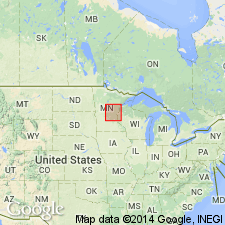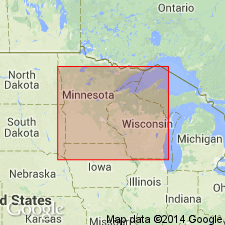
- Usage in publication:
-
- Sartell Gneiss
- Modifications:
-
- Named
- Dominant lithology:
-
- Gneiss
- AAPG geologic province:
-
- Lake Superior region
Summary:
Is part of Sauk Rapids Metamorphic Complex (new). Named for exposures just north of village of Sartell on east side of Mississippi River in Benton Co, east-central MN, Lake Superior region. Type locality designated in SW1/4 sec 4 of T36N, R30W. Other reference exposures occur in SW1/4 and NW1/4 sec 6, T125N, R28W. Geophysical data suggests gneiss extends west beneath Phanerozoic cover to at least vicinity of Long 95 deg West. Is truncated on east by reddish-gray, porphyritic granite of possible Stearns Granitic Complex. Sartell Gneiss consists of interlayered light-pinkish-gray quartzose feldspathic gneiss and light- to dark-brownish-gray garnet- and cordierite-bearing biotite gneiss. Biotite-bearing phase is highly variable in grain size and mineralogy, but consists of two facies: 1) brownish-gray, medium-grained, well-foliated rock having irregular clots and lenses of coarser grained granular material; and 2) brownish-gray, medium-grained, moderately massive gneiss. Is locally interlayered with Watab Amphibolite (new) and St. Wendel Metagabbro (new). Is early Precambrian in age.
Source: GNU records (USGS DDS-6; Denver GNULEX).

- Usage in publication:
-
- Sartell Gneiss*
- Modifications:
-
- Overview
- AAPG geologic province:
-
- Lake Superior region
Summary:
Is one of several gneisses present in the Lake Superior province, east-central MN in the Lake Superior region. Metamorphosed to upper amphibolite or granulite facies and deformed into gentle folds. Has not been dated radiometrically, but resembles Early or Middle Archean-aged rocks in the Minnesota River Valley.
Source: GNU records (USGS DDS-6; Denver GNULEX).
For more information, please contact Nancy Stamm, Geologic Names Committee Secretary.
Asterisk (*) indicates published by U.S. Geological Survey authors.
"No current usage" (†) implies that a name has been abandoned or has fallen into disuse. Former usage and, if known, replacement name given in parentheses ( ).
Slash (/) indicates name conflicts with nomenclatural guidelines (CSN, 1933; ACSN, 1961, 1970; NACSN, 1983, 2005, 2021). May be explained within brackets ([ ]).

